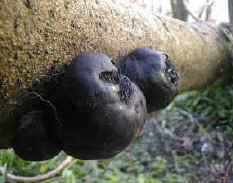 |
 |
 |
Types of Fungi
Introduction
|
 |
Fungi such as mushrooms, have hundreds of paper-thin folds, called gills, on the underside of the mushroom cap. The spores are produced all over these gills, which provide an enormous surface area base for the spores. Gills are sometimes also known as lamellae. |
|
Some other fungi have small tubes or pores within the fruiting body. The spores develop all over the inside of the pores, which again help to produce a large surface area. |
| Still other fungi have developed fruiting bodies covered with enormous numbers of tooth-like structures which bear the spores. Others just have large numbers of folds all over the fruiting body. All of these different methods for increasing surface area of the fruiting body and the different structures which result, provide a useful way to identify different kinds of fungi. |
|